7 Robust API Test Examples to Use in 2025
Reliable API testing is a cornerstone of modern software development, yet finding practical, comprehensive api test examples can be a significant challenge. Developers and QA engineers often spend valuable time piecing together snippets for success cases, error handling, timeouts, and network failures. This fragmented approach slows down development cycles, introduces blind spots in test coverage, and makes it difficult to simulate real-world conditions effectively. A lack of clear, actionable examples prevents teams from building robust, resilient applications that can gracefully handle unexpected API behavior. This guide is designed to solve that exact problem.
We have compiled a detailed list of platforms and tools that provide extensive api test examples and powerful simulation capabilities. Each entry in this listicle offers a strategic breakdown of how to implement critical test scenarios, from basic 200 OK responses to complex 429 rate-limiting and 503 service unavailable errors. You will find practical code snippets, setup tips for tools like dotMock, and direct links to get started immediately. Our goal is to provide a go-to resource that helps you move beyond simple happy-path testing and build a truly resilient testing strategy, ensuring your applications perform flawlessly under any condition.
1. dotMock
For teams seeking a powerful, all-in-one solution for generating comprehensive api test examples, dotMock stands out as an exceptional choice. It's a cutting-edge, cloud-based API mocking platform engineered to eliminate development bottlenecks. The platform empowers developers and QA teams to create realistic, production-ready mock APIs in under a minute, requiring zero complex configuration.
dotMock’s versatility is its core strength. It allows users to generate mock APIs through multiple methods, including capturing live HTTP traffic, importing OpenAPI/Swagger specifications, or even describing desired endpoints in plain English using its AI-powered generator. This flexibility ensures that no matter your workflow, you can rapidly produce the exact API behavior needed for robust testing and parallel development.
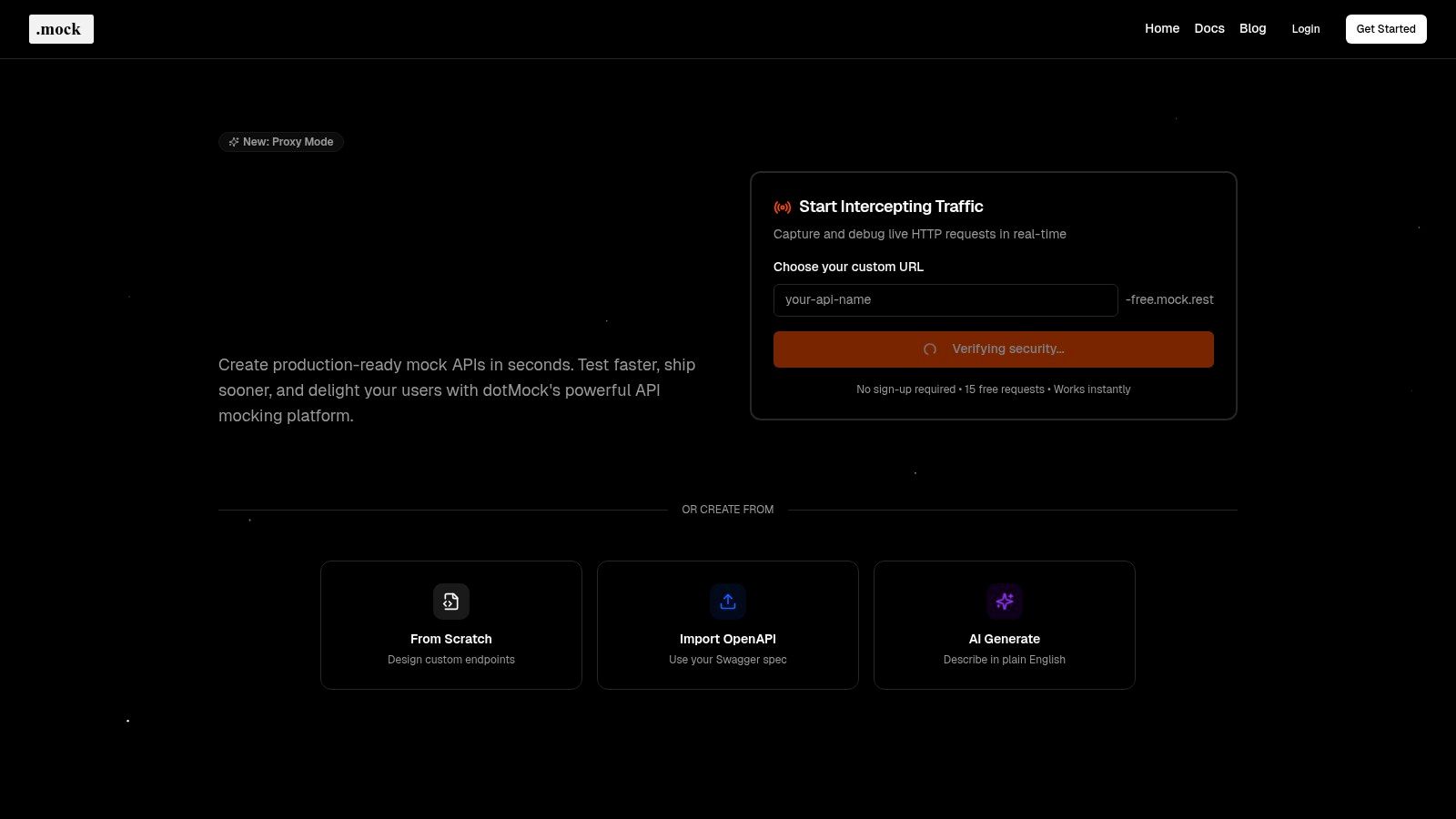
Why dotMock is Our Top Pick
dotMock excels by moving beyond simple success-case mocking. Its advanced fault injection capabilities are a game-changer for building resilient applications. This feature allows you to simulate a wide array of failure scenarios that are often difficult or risky to replicate in traditional testing environments.
Key Features for API Testing:
- Realistic Error Simulation: Easily configure endpoints to return specific HTTP status codes, like 500 Internal Server Error or 403 Forbidden, to test your application's error handling logic.
- Latency and Timeout Injection: Simulate slow network conditions or unresponsive APIs by introducing configurable delays. This is crucial for verifying that your application's UI remains responsive and timeouts are handled gracefully.
- Rate Limit Testing: Set up mock endpoints with specific rate limits to ensure your code correctly manages
429 Too Many Requestsresponses and implements proper backoff strategies. - Network Failure Simulation: Test how your application behaves during complete network failures, ensuring it can handle connection drops without crashing.
Strategic Insight: By integrating these failure simulations early in the development cycle, dotMock allows teams to adopt a "fail-first" testing mindset. This proactive approach helps uncover and fix resilience issues long before they impact production users, which is a core principle of modern service virtualization. For a deeper dive into this concept, you can learn more about service virtualization on dotmock.com.
Pricing and Access
dotMock offers a tiered pricing structure to accommodate different needs. A Free plan is available, which provides a great starting point for individual developers or small projects but comes with limits on daily requests and the number of mock endpoints.
For professional teams, the Pro and Enterprise plans unlock higher usage quotas, advanced collaboration features, and dedicated support, making it a scalable solution for organizations of any size.
Website: https://dotmock.com
2. Postman API Network
The Postman Public API Network is a massive, community-driven hub for discovering and using APIs. It stands out by offering thousands of pre-built "collections," which are runnable groups of API requests, often complete with authentication, documentation, and even test scripts. This makes it an invaluable resource for finding real-world api test examples that you can import and run with a single click.
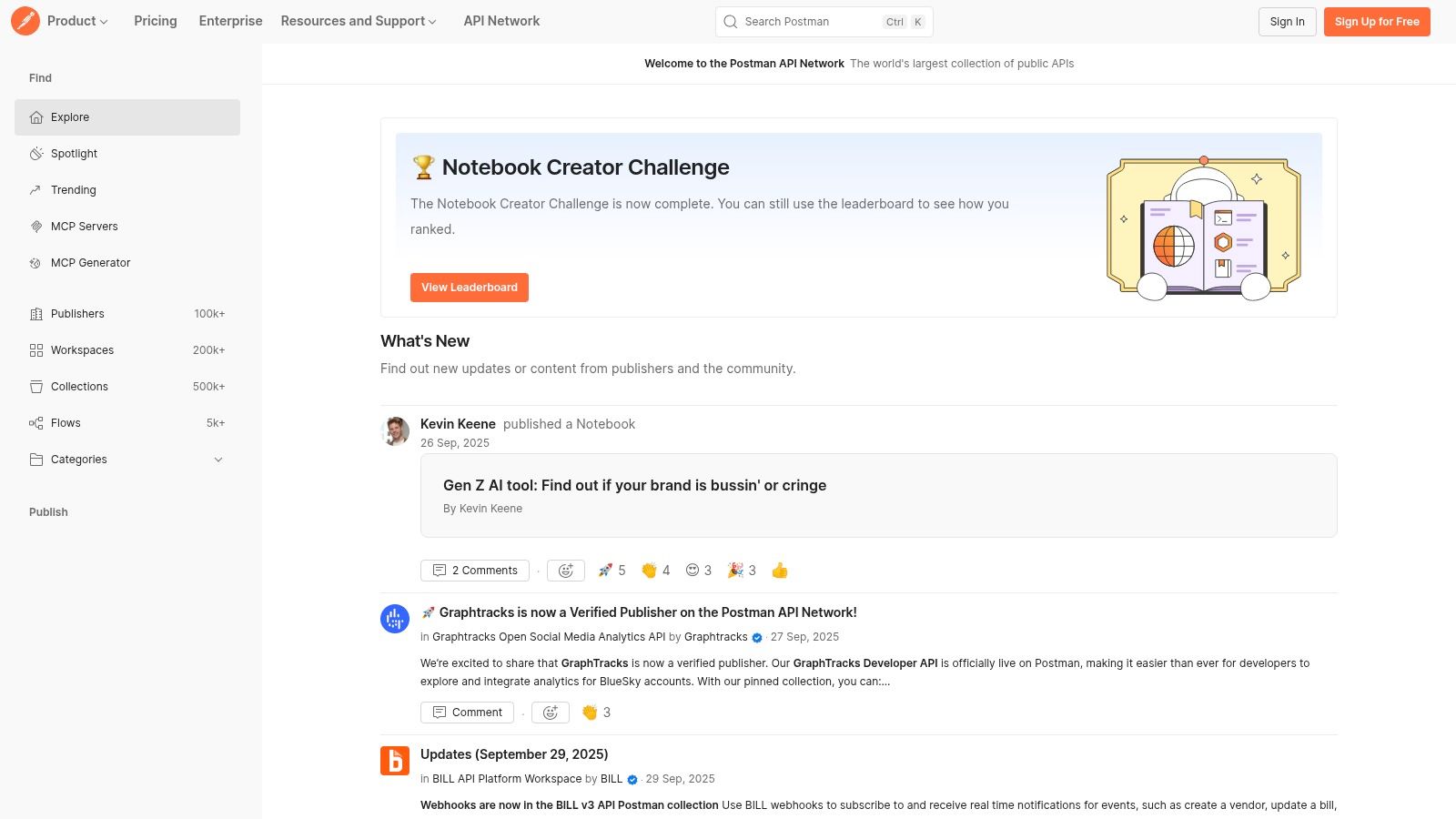
Unlike static documentation sites, the Postman Network provides an interactive learning environment. Developers can "fork" a collection, modify its requests, and immediately see the results in the Postman client. This hands-on approach is perfect for QA teams and developers who need to understand how an API behaves under various conditions.
Strategic Breakdown
- Key Offering: Interactive, runnable API collections with pre-configured tests and environments. This drastically lowers the barrier to entry for testing complex APIs like those from Stripe, Twitter, or Google Maps.
- Best For: Beginners needing guided examples and teams looking for well-documented, standardized API collections to build upon. The "Run in Postman" button is a powerful feature for instant setup.
- User Experience: The "Explore" tab offers curated and trending APIs, making discovery simple. The interface is clean, though navigating the sheer volume of content can sometimes be overwhelming.
Access and Pricing
Postman offers a generous free tier that is sufficient for most individual developers and small teams to explore and use public collections. Paid plans (Basic, Professional, and Enterprise) unlock advanced features like more extensive collaboration, higher usage limits for mock servers and monitoring, and private API network capabilities.
| Feature | Free Tier | Paid Tiers (Starting from $14/user/mo) |
|---|---|---|
| Public API Network | Full Access | Full Access |
| Collaboration | Basic (up to 3 users) | Advanced roles, permissions, private network |
| Mock Servers | Limited calls/month | Higher call limits |
| API Monitoring | Limited calls/month | Higher call limits and advanced features |
Actionable Takeaway: Use the Postman Network not just for finding examples, but for reverse-engineering complex test suites. Fork a popular collection, examine its "Tests" tab to see how its creators validate responses, and adapt those JavaScript-based tests for your own projects. For a deeper dive into the fundamentals, you can get more information on how to test REST APIs with Postman and other tools.
Website: https://www.postman.com/explore
3. RapidAPI Hub
RapidAPI Hub is a massive API marketplace that acts as a centralized platform for discovering, connecting to, and managing thousands of APIs. It simplifies the process by allowing users to subscribe to multiple APIs through a single account, with unified billing and analytics. Its key strength for testing is the ability to test endpoints directly in the browser, complete with auto-generated code snippets and clear documentation on pricing and rate limits.
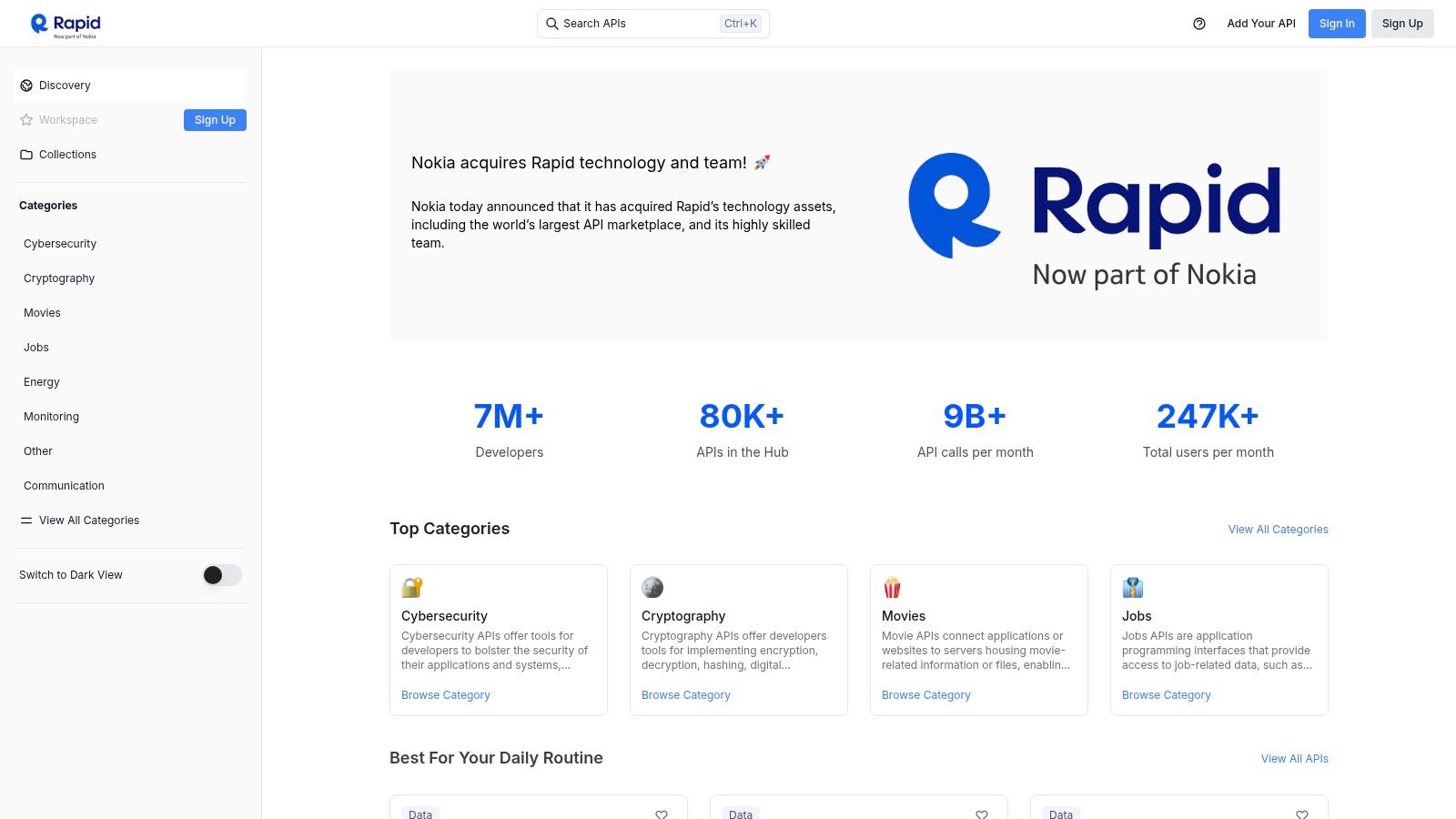
Unlike platforms focused purely on documentation, RapidAPI provides a live testing environment tied directly to subscription plans. This allows developers and QA teams to find real api test examples and immediately see how they will perform under specific usage quotas. You can test an API's free tier, then switch to a paid plan and observe changes in rate limits or access to different endpoints, all within the same interface.
Strategic Breakdown
- Key Offering: An integrated marketplace with in-browser API testing, unified subscriptions, and auto-generated code snippets. Many APIs offer generous free tiers perfect for experimentation.
- Best For: Teams needing to quickly find, evaluate, and integrate third-party APIs. The platform is excellent for testing authentication, rate limiting, and different subscription levels (e.g., free vs. pro) in a controlled environment.
- User Experience: The hub is well-organized, with powerful search and filtering capabilities. The "Endpoints" tab for each API provides an intuitive interface for setting parameters and viewing responses directly, making it highly accessible.
Access and Pricing
Access to the RapidAPI Hub itself is free. Pricing for APIs is set by individual providers and varies widely, but the platform standardizes the subscription model. Most APIs offer a freemium structure, allowing for substantial testing before commitment.
| Feature | Free Tier (Basic Plan on most APIs) | Paid Tiers (Pro, Ultra, Mega) |
|---|---|---|
| API Access | Limited requests/month (e.g., 500 calls) | High-volume requests (e.g., 10,000 to 1M+ calls) |
| Rate Limiting | Often stricter limits (e.g., 1 req/sec) | Higher concurrency and requests per second |
| Endpoint Access | Access to core endpoints | Access to premium or advanced endpoints |
| Billing | Single bill for all subscribed APIs | Unified billing with overage charges |
Actionable Takeaway: Use RapidAPI to deliberately test an API's boundaries. Find an API with a clear free tier and write tests that push its rate limits and request quotas to trigger 429 Too Many Requests errors. This is a perfect, low-cost way to validate your application's error handling and retry logic for a common production failure scenario.
Website: https://rapidapi.com/hub
4. SmartBear ReadyAPI
SmartBear ReadyAPI is a comprehensive, enterprise-grade suite designed for robust API quality management. It moves beyond simple request-response validation by offering a unified platform for functional, security, performance, and virtualization testing. Its strength lies in providing structured, reusable api test examples and templates, particularly for complex enterprise environments that handle multiple protocols like SOAP, REST, and GraphQL.
Unlike lightweight, single-purpose tools, ReadyAPI is an all-in-one solution that enables teams to build sophisticated end-to-end testing scenarios. For instance, you can generate functional tests directly from an OpenAPI specification, convert them into security scans to check for common vulnerabilities, and then use the same base case for a load test. This integrated approach helps organizations enforce API governance and maintain quality at scale.
Strategic Breakdown
- Key Offering: An integrated suite with specialized modules for different testing types (Test, Performance, Security, and Virtualization). It includes built-in sample projects that serve as excellent templates.
- Best For: Enterprise QA teams and organizations that require comprehensive API governance, security compliance, and performance validation across diverse protocols like SOAP, gRPC, and Kafka.
- User Experience: The interface is a feature-rich desktop application that feels powerful but can have a steeper learning curve compared to web-based tools. Its project-based organization is logical for managing large test suites.
Access and Pricing
ReadyAPI is a commercial product with licensing based on the specific modules a team needs (Test, Performance, Security). SmartBear offers a 14-day free trial for the full suite. Pricing is quote-based and tailored to team size and feature requirements, positioning it as a premium tool for organizations with significant API testing needs.
| Feature | Free Trial (14 days) | Paid Tiers (Quote-based) |
|---|---|---|
| Test Module | Full Access | Unrestricted Use |
| Security Module | Full Access (pre-defined scans) | Unrestricted Use & Custom Scans |
| Performance Module | Full Access (unlimited virtual users) | Unrestricted Use |
| CI/CD Integration | Included | Included (Jenkins, Azure DevOps, Docker) |
Actionable Takeaway: Leverage the "Security Test Generator" to instantly create a baseline of security-focused api test examples. Point it at your API's definition file (like an OpenAPI spec), and it will automatically generate tests for common vulnerabilities such as SQL injection, cross-site scripting (XSS), and invalid input fuzzing. This is an incredibly fast way to establish a foundational security test suite without writing a single script.
Website: https://smartbear.com/product/ready-api
5. Katalon Platform
The Katalon Platform is a comprehensive test automation solution that extends beyond the web and mobile into robust API testing. It distinguishes itself by offering a unified environment where teams can create, execute, and manage API tests using either a low-code interface or a full-code scripting mode in Groovy. This dual approach makes it an excellent resource for finding practical api test examples that cater to both manual QA testers and seasoned automation engineers.
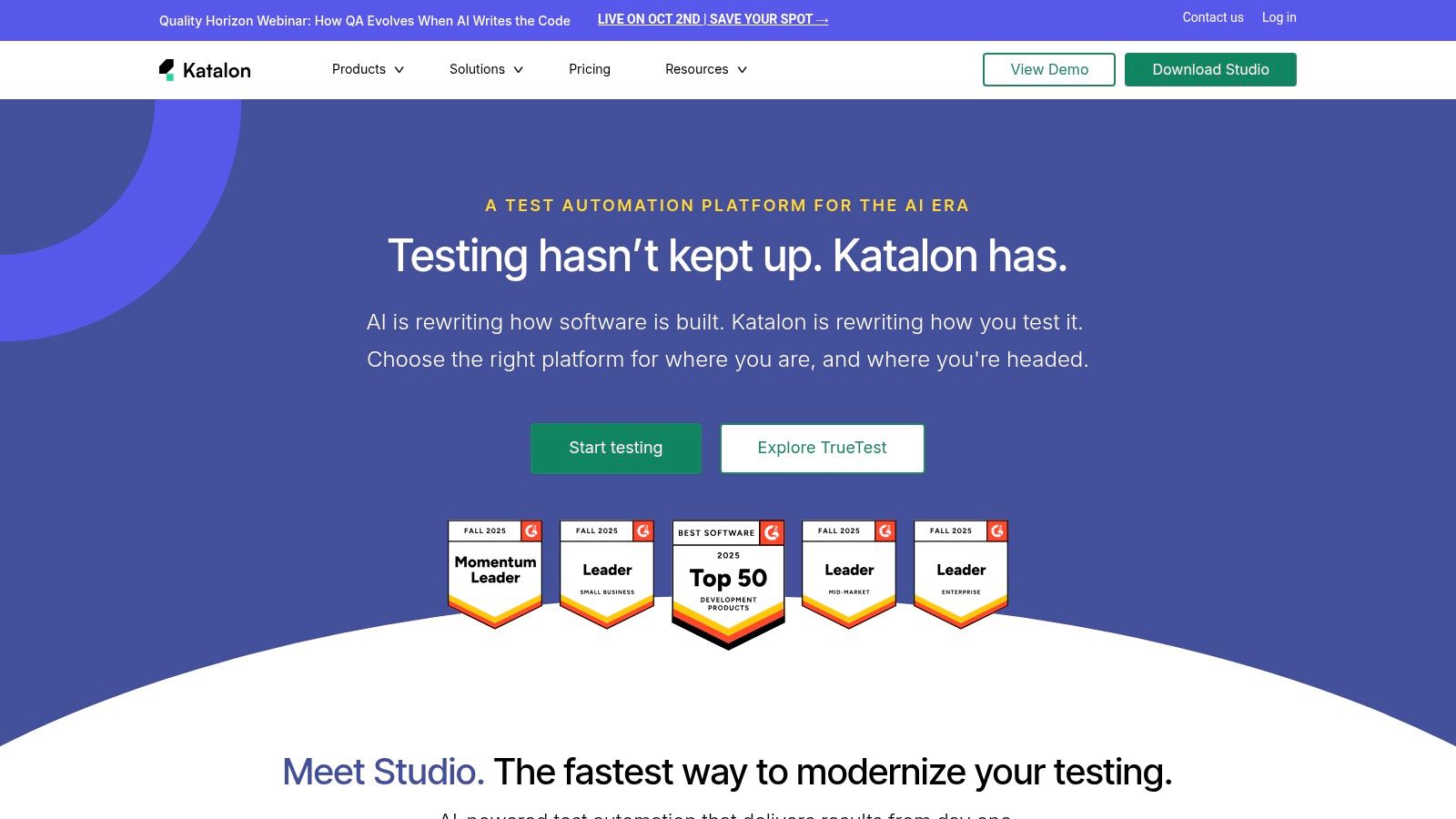
Unlike tools focused solely on API requests, Katalon provides a holistic testing ecosystem. Users can easily chain API tests with UI or mobile test steps, enabling true end-to-end scenario validation. Its extensive documentation and Katalon Academy courses are filled with guided tutorials that break down complex testing concepts like data-driven validation and schema compliance into manageable steps.
Strategic Breakdown
- Key Offering: A hybrid low-code and full-code platform for creating, running, and analyzing API tests. It supports REST, SOAP, and GraphQL requests and integrates them into broader test automation workflows.
- Best For: QA teams seeking a single tool for web, mobile, and API testing, especially those with mixed technical skill sets. The guided approach is ideal for learning how to structure API tests from scratch.
- User Experience: The Katalon Studio interface is well-organized, with a clear separation between test objects, test cases, and test suites. While powerful, the sheer number of features can present a learning curve for complete beginners.
Access and Pricing
Katalon offers a free plan with a solid set of core features for individual users. For teams needing advanced collaboration, cloud-based test execution (TestCloud), and enhanced reporting, Katalon offers paid tiers (Premium and Ultimate). Pricing is modular, depending on the number of users and required test execution sessions.
| Feature | Free Plan | Paid Tiers (Starting from $167/mo) |
|---|---|---|
| API Test Authoring | Full Access (REST, SOAP, GraphQL) | Full Access |
| Collaboration | Basic | Advanced test artifact sharing and permissions |
| CI/CD Integration | Yes (via command-line) | Native integrations, advanced pipeline control |
| Cloud Execution | Not included | Parallel execution sessions in Katalon TestCloud |
Actionable Takeaway: Leverage Katalon's data-driven testing features to build more resilient API test suites. Instead of creating dozens of separate tests for different inputs, use a single test case linked to a data file (like a CSV or Excel sheet) containing various input combinations, including edge cases and invalid data, to automatically generate and run a wide array of test scenarios.
Website: https://katalon.com
6. SwaggerHub
SwaggerHub is a collaborative platform built around the OpenAPI Specification (OAS), providing a centralized place for teams to design, document, and manage their APIs. Its real strength for testing lies in its interactive documentation, which automatically generates a user interface where you can execute live API calls directly in your browser. This makes it an ideal environment for finding hands-on api test examples based on well-defined standards.
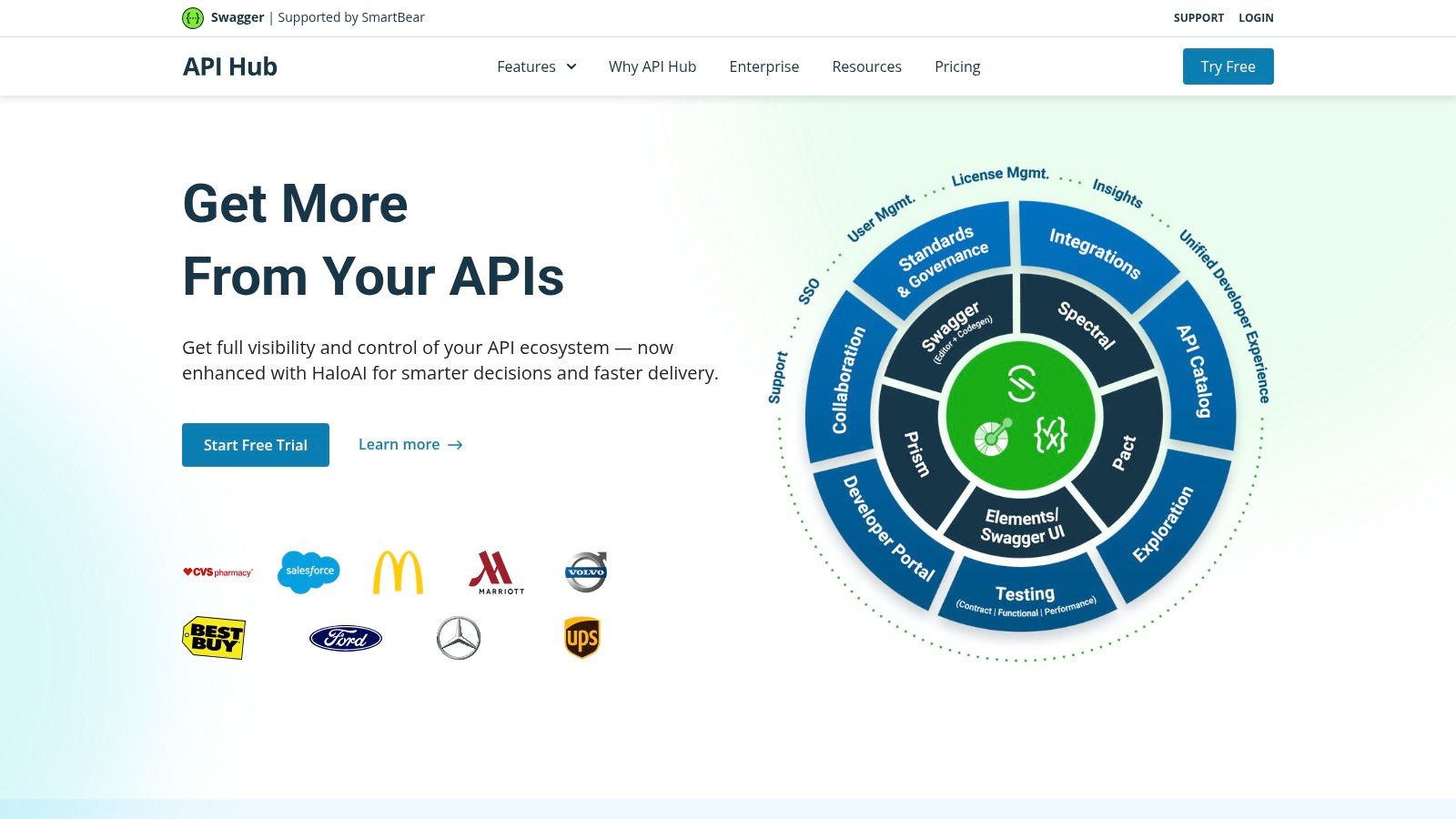
Unlike repositories that simply list APIs, SwaggerHub embeds the testing experience within the documentation itself. Developers and QA engineers can read about an endpoint, see its expected parameters and responses, and then immediately click "Try it out" to send a real request. The famous Swagger Petstore API is a canonical example used across the industry for learning and demonstrations, offering a perfect, ready-to-use testing playground.
Strategic Breakdown
- Key Offering: Hosted, interactive API documentation that allows for live endpoint testing directly from the definition. It enforces API-first design principles, ensuring documentation is the single source of truth.
- Best For: Teams committed to the OpenAPI Specification and developers who want to test against a formal contract. It’s excellent for ensuring your implementation matches the documented design.
- User Experience: The UI is clean and specification-driven. The "Try it out" feature is intuitive, automatically generating cURL commands and showing live response codes, headers, and bodies, which simplifies debugging.
Access and Pricing
SwaggerHub provides a free plan suitable for individuals and small projects, offering core features like the editor and interactive documentation for public APIs. Paid plans are designed for teams and enterprises, introducing critical features for governance, collaboration, and private API management.
| Feature | Free Tier | Paid Tiers (Starting from $75/month) |
|---|---|---|
| API Definitions | Unlimited public APIs, 3 private APIs | Unlimited private and public APIs |
| Collaboration | Single user | Team-based with roles and permissions |
| Interactive Docs | Included | Included |
| Style Validation | Basic | Advanced, customizable style guides |
Actionable Takeaway: Use SwaggerHub's interactive documentation to validate your API client's behavior against the official specification. Find an API relevant to your project, execute a request using the "Try it out" feature, and then replicate that exact request in your own code. This ensures your implementation correctly handles the authentication, headers, and body structure defined in the OAS document.
Website: https://swagger.io/tools/swaggerhub/
7. JSONPlaceholder
JSONPlaceholder is a free, no-setup-required fake REST API that serves as an instant backend for prototyping, tutorials, and testing. It provides a set of common resources like posts, users, and todos with realistic data structures, making it the go-to service for developers who need reliable mock data without any configuration. Its simplicity is its greatest strength, offering a stable environment for creating foundational api test examples.
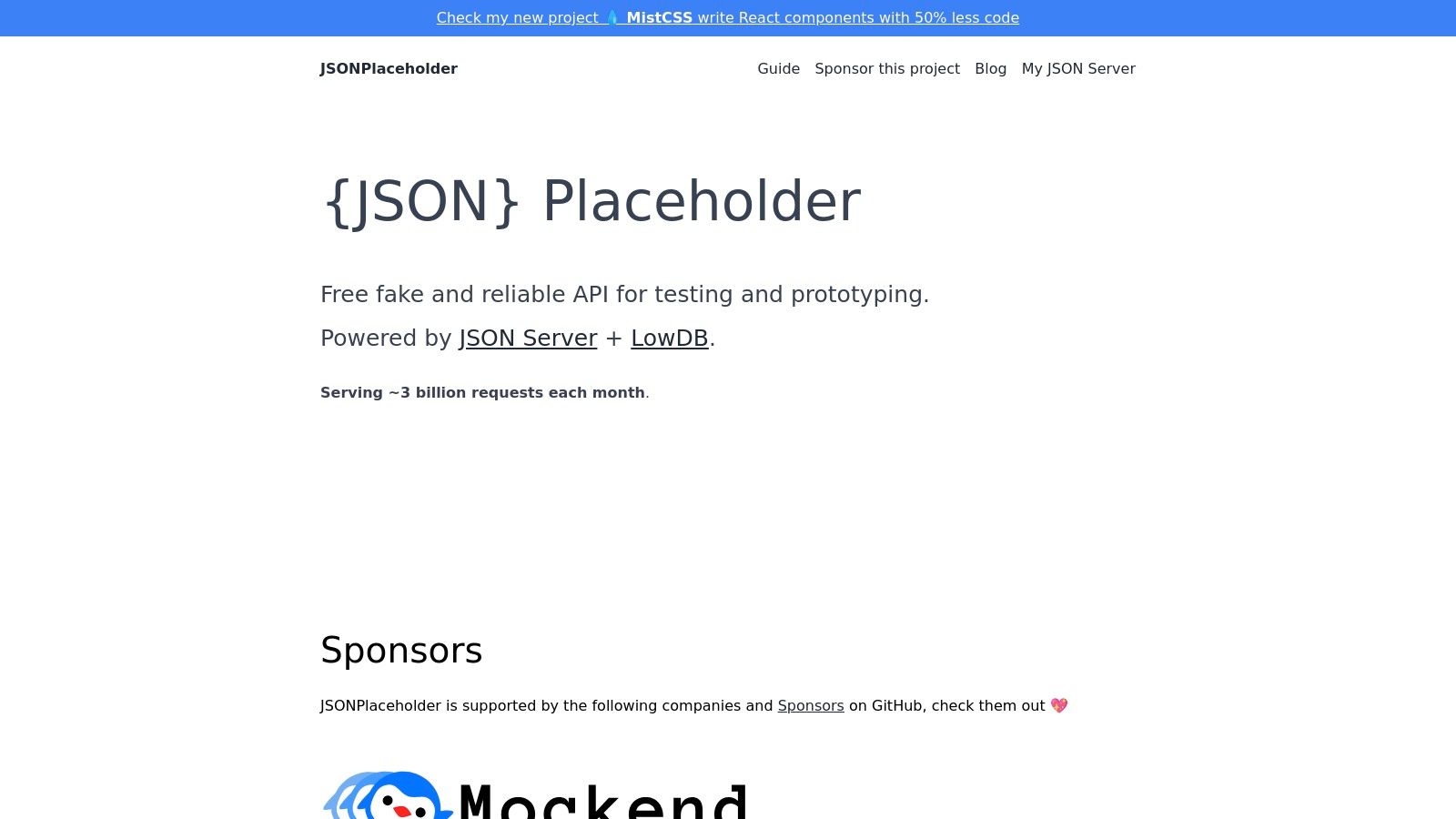
Unlike more complex API mocking tools, JSONPlaceholder is instantly accessible and requires no authentication, keys, or sign-up. This "zero-friction" approach allows developers and QA engineers to immediately write and execute tests against a live, predictable endpoint. It is an ideal sandbox for learning API consumption, running CI smoke tests, or demonstrating frontend components that rely on API data.
Strategic Breakdown
- Key Offering: A public, free-to-use fake REST API with standard HTTP methods (GET, POST, PUT, DELETE) and CORS support. It offers predictable JSON responses for resources like
/posts,/comments, and/users. - Best For: Beginners, educators, and teams needing a quick, reliable data source for demos, tutorials, or initial test suite development. It is perfect for testing HTTP clients and data parsing logic.
- User Experience: The user experience is minimal and developer-focused. The homepage provides all the necessary resource endpoints and examples, making it incredibly easy to get started in seconds.
Access and Pricing
JSONPlaceholder is completely free and public, with no accounts, API keys, or pricing tiers. It is designed for open access, although it is not intended for high-volume production use and comes with no service-level agreement (SLA).
| Feature | Availability | Cost |
|---|---|---|
| Fake REST API | Publicly accessible 24/7 | Free |
| HTTP Methods | GET, POST, PUT, PATCH, DELETE | Free |
| Authentication | None required | N/A |
| Data Persistence | Data is reset; not stateful | N/A |
Actionable Takeaway: Use JSONPlaceholder to build your initial test scaffolding. Create a base set of API tests for CRUD operations (Create, Read, Update, Delete) against its endpoints. While mock APIs are excellent for basic testing, real-world scenarios involve complex interactions. For instance, when managing service expenses, you might need to understand the process for downloading OpenAI API invoices from a live, authenticated endpoint, which requires a different testing strategy. For a more fundamental understanding of the concepts involved, you can learn more about what is API testing in a broader context.
Website: https://jsonplaceholder.typicode.com/
API Test Examples Comparison Matrix
| Platform | Implementation Complexity 🔄 | Resource Requirements ⚡ | Expected Outcomes 📊 | Ideal Use Cases 💡 | Key Advantages ⭐ |
|---|---|---|---|---|---|
| dotMock | Low – Zero configuration, cloud-based ready-to-use | Minimal – Cloud-hosted, supports team scale | High – 10x faster release cycles, resilient apps | Parallel frontend/backend dev, fault testing | Fast setup, multi-method mock generation, advanced fault injection |
| Postman API Network | Very Low – Ready-to-run API collections, templates | Low – Uses Postman client/web | Moderate – Quick testing and learning | Beginners, teams needing curated examples | Huge public library, easy discovery & use |
| RapidAPI Hub | Moderate – Marketplace with subscription management | Moderate – Depends on API plans | Moderate – Easy test & compare APIs | API discovery, subscription, test scenarios | Extensive API catalog, free tiers, in-browser tests |
| SmartBear ReadyAPI | High – Enterprise suite with extensive features & integrations | High – Requires more powerful infrastructure | Very High – Comprehensive functional/security testing | Large organizations needing governance | Robust multi-protocol support, security scans, CI/CD integration |
| Katalon Platform | Moderate – Low-code + full-code options | Moderate – On-prem/cloud execution | High – Unified automation with reporting | Teams wanting integrated testing across platforms | Accessible for beginners, extensive tutorials, scalable |
| SwaggerHub | Low to Moderate – Focus on API design and documentation | Minimal – Cloud-hosted | Moderate – Consistent, testable API definitions | API design, documentation, team collaboration | Strong standards support, live API testing via Explore |
| JSONPlaceholder | Very Low – Public fake API with no setup | None – Public free API | Basic – Static mock data for examples | Quick demos, tutorials, smoke tests | Instant use, zero config, realistic fake data |
Final Thoughts
The journey through these diverse api test examples has demonstrated a critical truth in modern software development: robust API testing is not a single action, but a comprehensive strategy. We've moved beyond simple success-case validation and explored the nuanced, often chaotic, realities of real-world API interactions. From simulating network timeouts with dotMock to validating schema compliance in SwaggerHub and testing error handling with Postman, each example provides a tactical piece of a much larger puzzle.
The core lesson is that proactive and varied testing is essential. Waiting for a production environment to reveal a rate-limiting issue or an unexpected network failure is a recipe for disaster. By embracing a "fail-first" mindset and using these tools to simulate adverse conditions, you shift from reactive debugging to proactive resilience engineering.
Key Takeaways for Implementing API Test Examples
To translate these examples into actionable improvements for your workflow, keep the following strategic points in mind:
- Embrace Comprehensive Scenarios: Don't just test the "happy path." The most valuable insights come from testing for failure. Intentionally trigger
4xxand5xxerror codes, simulate network latency, and test authentication failures to build truly resilient applications. - Isolate Dependencies with Mocking: Tools like dotMock and JSONPlaceholder are invaluable for decoupling development. Frontend, backend, and QA teams can work in parallel, using stable, predictable mock APIs to avoid bottlenecks and accelerate development cycles. This isolation is crucial for targeted unit and integration testing.
- Automate for Consistency: Manual testing with tools like Postman is excellent for exploration, but a scalable strategy relies on automation. Integrate your API tests into your CI/CD pipeline using platforms like Katalon or scripting Postman collections to ensure every code change is validated automatically, catching regressions before they reach users.
- Documentation is a Testing Tool: Leverage API documentation platforms like SwaggerHub not just for reference, but as an active part of your testing process. Use the defined schema to generate contract tests, ensuring that your API's implementation never deviates from its specification.
Choosing the Right Tool for the Job
Selecting the appropriate tool depends entirely on your immediate goal. Are you a frontend developer needing a quick, reliable mock server to build a UI? A free service like JSONPlaceholder or a dedicated tool like dotMock is your best bet. Are you a QA engineer tasked with building a comprehensive regression suite? A full-featured platform like ReadyAPI or Katalon will provide the necessary power and organization.
Consider these factors when making your decision:
- Complexity: Do you need simple GET requests or complex stateful scenarios with authentication?
- Collaboration: Will multiple team members need to access and modify the tests and mocks?
- Automation: Is integration with a CI/CD pipeline a primary requirement?
- Realism: How accurately do you need to simulate real-world conditions like latency and network failures?
By carefully evaluating these needs against the api test examples we've covered, you can build a powerful, multi-layered testing strategy that ensures your APIs are not just functional, but truly dependable. This proactive approach is the foundation of high-quality software and exceptional user experiences.
Ready to move from theory to practice? The api test examples in this article highlight the power of realistic simulation. dotMock is purpose-built for this, allowing you to create high-fidelity mock APIs in seconds that simulate latency, errors, and timeouts. Stop waiting on backend dependencies and start building more resilient applications today by visiting dotMock.